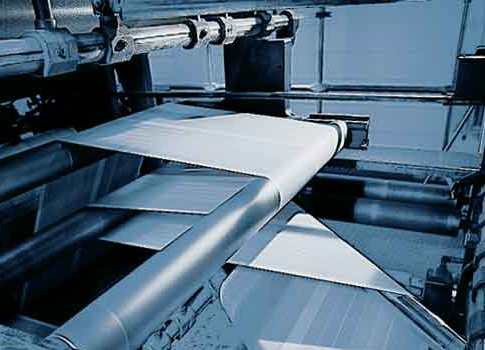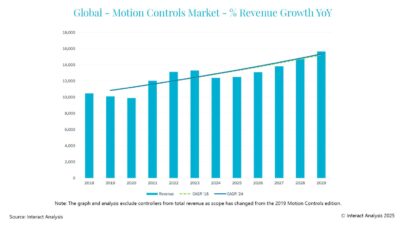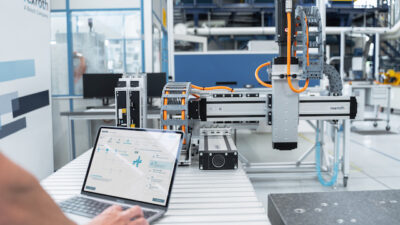Tension control solution for digital roll-to-roll web process enables highest quality, high throughput of printed electronics.

One of the brightest developments in electronics is organic light emitting diode (OLED) TVs, which are attracting consumers with their eye-popping colors and super-thin designs. Unlike the components found in traditional flat-screen display technology, OLEDs use thin, flexible sheets of material that emit their own light and are produced using a technique similar to inkjet or sheet-feed printing.
Introduced to the consumer market only a few years ago, OLEDs are still relatively costly to manufacture in large sizes due to limitations in shadow-mask deposition methods, and in newer laser annealing and inkjet printing techniques. To scale up large area display production economically, printed electronics manufacturers are seeing the benefits of another production method—namely, digital roll-to-roll web processing enabled by multi-axis tension control solutions.
Originally developed for digital printing, multi-axis tension control has been found to be an excellent solution for roll-to-roll manufacturing of printed electronics, such as large area OLEDs, e-paper media, and integrated circuits. Like an inkjet printer deposits ink on sheets of paper, a digital roll-to-roll press patterns thin-film transistors and other devices directly onto large organic, flexible substrates. But unlike slower sheet-fed digital printing, the substrate in a roll-to-roll press is supplied from an infeed reel through the printing section onto an outfeed reel in one continuous inline web. An array of piezoelectric printheads deposits the ink (a conductive organic solution) on the substrate at precise locations.
It all happens on the fly. For example, digital printers using precision controls operate at speeds up to 800 ft (240 m) per minute. In roll-to-roll web processing, electroluminescent materials or other microcrystalline layers are deposited on substrate at slower speeds, on the order of 10 ft to 100 ft (3-30 m) per minute. The speed of the roll-to-roll process dramatically reduces the cost of fabrication, but several challenges must be overcome to make it pay off.
Fast speeds create big challenges
Similar to how Sunday newspaper comics require precise color registration to keep images from blurring, printed electronics require far tighter registration. Tolerances for applications such as thin-film transistors (TFTs) or OLEDs require registration smaller than 10 microns. High-speed, high-resolution cameras measure registration accuracy and provide input to the control system. To ensure that degree of accuracy, precise web tension control is required.
From the experience gained as a market leader in digital printing, Rexroth developed web tension control technology that is now being implemented to address digital roll-to-roll processing’s main challenge, running at high speeds while maintaining high registration accuracy.
Web tension control
Achieving precise registration accuracy is a factor of two related variables: web tension and transport velocity.
Web transport control ensures proper uniform tension on the substrate web as it travels through the process. Because the substrate changes properties in response to force loading, changes in tension affect the stability of deposited materials. Substrate expansion causes cracks, broken traces, short circuiting, and layer delamination. Changes in web velocity in the print zone affect registration, thickness, and resolution of fine lines.
As the web travels downstream, constant tension must be maintained in each tension zone, which is defined as an isolated area in a machine where constant tension must be maintained appropriate to the process being performed in that area. A roll-to-roll press has several tension zones. Problems occur when a change is made in one tension zone and no change is needed in other areas. When tension control is coupled between all zones, a change in one creates a cascade of changes in others, impacting the stability of the entire web.
Figure 1 shows how instability affects a web traveling at 5 meters per second with two successive tension controllers for two tension zones. A command for a step change tension reduction is sent to the green zone controllers. No change is required in the upstream blue zone. But because the web is continuous, the tension disturbance is carried back to the blue zone, which causes the blue controller to compensate. In turn, this change affects the downstream green zone, sending jitter back to the blue zone. This back-and-forth jitter takes about 85 seconds to settle down. The web tension finally stabilizes in about 90 seconds. During that time, the machine is yielding waste product.
Tension adjustment challenge
In an ideal world, web instability would never occur because tension adjustment would never be needed. But tension adjustment is necessary due to several mechanical factors:
- Oscillations caused by mechanical misalignments
- Differing inertial response (lag) of mechanical elements during web acceleration
- Out-of-round unwind and tension rolls
- Slipping through nip rolls
- Over-aggressive web-guide correction
Several technical process and control issues also affect tension: tension setpoint changes, phase offset on driven rolls, tension bleed from one zone to another, and, of course, thermal effect (contraction/expansion) as the substrate passes through various processes.
The factors requiring tension adjustment cannot all be eliminated. Variance in any one factor in a zone necessitates changes in tension control and web speed. Consequently, with coupled tension zone control, jitter is inevitable in a continuous web where the controllers cause a feedback loop.
Decoupled controllers: Benefits
There is a solution. Decouple each tension zone, allowing each controller to operate independently.
This has been accomplished in digital printing applications using precision controllers incorporating a unique tension decoupling function block. As the name implies, the function block allows tension control for each zone to operate independently. As a result, tension changes can be isolated in one zone without affecting tension change in other areas.
See next page for more information and another diagram.
The result can be seen in Figure 2. In this example, the press uses two successive controllers. But now the step change signaled by the green section controller doesn’t create a cascade effect upstream. Along with decoupling to prevent feedback, the controller initiates a response to step reduction in tension control in one-fourth the time compared to typical controllers.
With the solution described, tension can be controlled for up to eight axes. One or multiple points can be selected to be left uncontrolled. At the selected axis, line speed is held constant. At a standstill, web tension can be maintained. In fact, multi-axis tension control increases standstill web tension accuracy by a factor of two to four. Achieving the desired standstill web tension is also much faster. Without decoupling, a setpoint can be achieved in 13-14 seconds; with decoupling, it takes three to four seconds.
During acceleration, tension control decoupling ensures the web is stable as soon as full production speed is reached, compared to a delay of five seconds or longer with coupled control. And when tension setpoint changes occur during runtime, the transient response with decoupling takes about one second, compared to about four seconds with coupled control.
Not unlike digital printing, the adoption of roll-to-roll web printing will accelerate as the technology demonstrates its ability to provide high accuracy at high speeds. At the outset, however, the process with tension control offers several bottom-line benefits: the roll-to-roll web starts faster, saving time and increasing output; longer periods of web stability reduce waste and increase yield; and less tension deviation on the substrate improves registration and enables the use of more sensitive material.
And, because printed electronic material can be 10 times the cost, or even significantly more expensive, than typical substrate, decoupled multi-axis tension control technology promises a significant payback. Original equipment manufacturers (OEMs) get an off-the-shelf solution providing the most stable tension solution for roll-to-roll machines. The result is faster time to market and easier implementation thanks to integrated components, including drives, function blocks, and software controls. By enabling tight registration and greater throughput, decoupled tension control can handle the challenges OEMs face when building roll-to-roll presses today—and promises a bright future for large-scale printed electronics manufacturing tomorrow.
– Bosch Rexroth provided the information. Edited by Mark T. Hoske, content manager, CFE Media, Control Engineering and Plant Engineering, [email protected].
Key concepts
- Multi-axis tension control solution allows the web to be decoupled into separate tension control zones. Tension can be adjusted as required in one zone area without destabilizing the entire web.
Consider this
- Could a multi-axis tension controller help improve performance of your web-based application?
Online
Rexroth web tension and printing solutions
www.boschrexroth-us.com/printing
www.boschrexroth-us.com



